A Comprehensive Review of Acoustic Methods for Locating Underground Pipelines
Abstract
:1. Introduction
2. Theoretical Study on Wave Propagation Mechanism in Pipe Systems
3. Acoustic Methods for Locating Buried Pipelines
3.1. Traditional Acoustic Transmission Technique
3.2. Pipe Excitation Method—Improved Acoustic Transmission Technique
3.3. Point Vibration Measurements
3.4. Seismic Wave Methods
3.4.1. Compressional Wave Method
3.4.2. Shear Wave Method
3.4.3. Surface Wave (Rayleigh Wave) Method
3.4.4. Summary of Seismic Wave Methods
4. Commercially Available Acoustic Locators
4.1. Pipe Locators Based on the Traditional Acoustic Transmission Method
4.2. Ultra-Trac® Acoustic Pipe Locator (APL)
4.3. Seismograhhy/Surface Wave Tester
5. Factors Affecting Acoustic Methods in Pipeline Localization
5.1. Background Noise
5.2. In Pipe Medium and Pipe Material
5.3. Pipe Structure: Discontinuity and Bend
5.4. Soil Property
6. Selection of Pipeline Localization Methods
7. Conclusions and Future Research
- The pipe excitation method possesses robust performance in the presence of background noise. However, it has limitations of access requirement to the pipe and the inability to estimate the burial depth. It is thus suggested to explore alternative ways to excite the fluid-dominated wave for pipe localization with no access to the pipe as well as its potential ability to estimate depth.
- The advantages of seismic wave methods are that access to the target is not required and burial depth can be determined from images. In order to improve the efficiency of seismic methods, both hardware and signal processing methods are expected to be optimized for better performance.
- The vibro-acoustic localization methods are still at an early stage of development, with gaps between the exiting designs and commercial needs. Commercial products are expected to be commenced in near future.
- Each method has its own advantages and drawbacks. Developing ways of combining different methods is a trend for future research.
Author Contributions
Funding
Acknowledgments
Conflicts of Interest
References
- The World Factbook-Central Intelligence Agency. Available online: https://www.cia.gov/library/publications/the-world-factbook/fields/2117.html (accessed on 22 December 2019).
- Pipeline Transport. Available online: https://en.wikipedia.org/wiki/Pipeline_transport#cite_note-cia-1 (accessed on 22 December 2019).
- Bruschini, C. Metal detectors in civil engineering and humanitarian de-mining: overview and tests of a commercial visualising system. Insight 2000, 42, 89–97. [Google Scholar]
- Das, Y. Effects of soil electromagnetic properties on metal detectors. IEEE Trans. Geosci. Remote Sens. 2006, 44, 1444–1453. [Google Scholar] [CrossRef]
- Tong, L. Ground penetrating radar applied in locating underground pipes. In Proceedings of the 15 International No-Dig, Taipei, Taiwan, 26–28 Novemeber 1997. [Google Scholar]
- Pettinelli, E.; di Matteo, A.; Mattei, E.; Crocco, L.; Soldovieri, F.; Redman, J.D.; Annan, A.P. GPR response from buried pipes: Measurement on field site and tomographic reconstructions. IEEE Trans. Geosci. Remote Sensing 2009, 47, 2639–2645. [Google Scholar] [CrossRef]
- Lai, W.W.; Lai, W.W.L.; Chang, R.; Sham, J.; Pang, K. Perturbation mapping of water leak in buried water pipes via laboratory validation experiments with high-frequency ground penetrating radar (GPR). Tunn. Undergr. Space Technol. 2016, 52, 157–167. [Google Scholar] [CrossRef]
- Davis, P.; Burn, S.; Moglia, M.; Gould, S. A physical probabilistic model to predict failure rates in buried PVC pipelines. Reliab. Eng. Syst. Saf. 2007, 92, 1258–1266. [Google Scholar] [CrossRef]
- Jeong, H.S.; Arboleda, C.A.; Abraham, D.M.; Halpin, D.W.; Bernold, L.E. Imaging and Locating Buried Utilities; Lafayette, IN, USA, 2003. [Google Scholar]
- Sterling, R.; Anspach, J.H.; Allouche, E.N.; Simicevic, J.; Rogers, C.D.; Weston, K.E.; Hayes, K. Encouraging Innovation in Locating and Characterizing Underground Utilities; T.R. Board: Washington, DC, USA, 2009. [Google Scholar]
- Katz, A.; Karaa, F.; Niver, E. Innovative and Effective Techniques for Locating Underground Conduits; New Jersey Institute of Technology: Newark, NJ, USA, 2011. [Google Scholar]
- Muggleton, M.J.; Rustighi, E. Mapping the Underworld: recent developments in vibro-acoustic techniques to locate buried infrastructure. Géotechnique Lett. 2013, 3, 137–141. [Google Scholar] [CrossRef] [Green Version]
- Royal, A.C.D.; Rogers, C.D.F.; Atkins, P.R.; Brennan, M.J.; Chapman, D.N.; Cohn, A.G.; Curioni, G.; Foo, K.Y.; Goddard, K.; Lewin, P.L.; et al. Mapping the Underworld: Location Phase II-Latest Developments. In Proceedings of the International No-Dig 2010, 28th International Conference and Exhibition, Singapore, 8–10 November 2010. [Google Scholar]
- Royal, A.; Rogers, C.; Atkins, P.; Chapman, D.; Chen, H.; Cohn, A.; Foo, K.; Goddard, K.; Hayes, R.; Hao, T. Mapping the Underworld: A Step-Change in the Approach to Utility Location and Designation. In ICPTT 2011: Sustainable Solutions For Water, Sewer, Gas, And Oil Pipelines; American Society of Civil Engineers (ASCE): Reston, VA, USA, 2011; pp. 1589–1597. [Google Scholar]
- Fuchs, H.V.; Riehle, R. Ten years of experience with leak detection by acoustic signal analysis. Appl. Acoust. 1991, 33, 1–19. [Google Scholar] [CrossRef]
- Liang, W.; Zhang, L.; Xu, Q.; Yan, C. Gas pipeline leakage detection based on acoustic technology. Eng. Fail. Anal. 2013, 31, 1–7. [Google Scholar] [CrossRef]
- Li, S.; Zhang, J.; Yan, D.; Wang, P.; Huang, Q.; Zhao, X.; Cheng, Y.; Zhou, Q.; Xiang, N.; Dong, T. Leak detection and location in gas pipelines by extraction of cross spectrum of single non-dispersive guided wave modes. J. Loss Prev. Process Ind. 2016, 44, 255–262. [Google Scholar] [CrossRef]
- Wirahadikusumah, R.; Abraham, D.M.; Iseley, T.; Prasanth, R.K. Assessment technologies for sewer system rehabilitation. Autom. Constr. 1998, 7, 259–270. [Google Scholar] [CrossRef]
- Hao, T.; Rogers, C.D.F.; Metje, N.; Chapman, D.N.; Muggleton, J.M.; Foo, K.Y.; Wang, P.; Pennock, S.R.; Atkins, P.R.; Swingler, S.G.; et al. Condition assessment of the buried utility service infrastructure. Tunn. Undergr. Space Technol. 2012, 28, 331–344. [Google Scholar] [CrossRef]
- Muggleton, M.J.; Rustighi, E. A Novel Method for the Remote Condition Assessment of Buried Pipelines Using Low-Frequency Axisymmetric Waves; Institute of Physics Publishing: Bristol, UK, 2016. [Google Scholar]
- Salimi, M.; Muggleton, J.; Rustighi, E. Pipe Assessment and Remote Condition Using an in-Pipe Excitation Technique. In Proceedings of the 6th International Conference on Acoustics & Vibration, Tehran, Iran, 7–8 December 2016. [Google Scholar]
- Lamb, H. On the velocity of sound in a tube, as affected by the elasticity of the walls. Manch. Mem. 1898, 42, 1–16. [Google Scholar]
- Fay, R.; Brown, R.; Fortier, O. Measurement of acoustic impedances of surfaces in water. J. Acoust. Soc. Am. 1947, 19, 850–856. [Google Scholar] [CrossRef]
- Jacobi, W.J. Propagation of sound waves along liquid cylinders. J. Acoust. Soc. Am. 1949, 21, 120–127. [Google Scholar] [CrossRef]
- McFadden, J. Radial Vibrations of Thick-Walled Hollow Cylinders. J. Acoust. Soc. Am. 1954, 26, 714–715. [Google Scholar] [CrossRef]
- Gazis, D.C. Exact Analysis of the Plane-Strain Vibrations of Thick-Walled Hollow Cylinders. J. Acoust. Soc. Am. 1958, 30, 786–794. [Google Scholar] [CrossRef]
- Pochhammer, L. Beitrag zur Theorie der Biegung des Kreiscylinders. J. die reine Angew. Math. 1876, 81, 33–61. [Google Scholar]
- Gazis, D.C. Three-dimensional investigation of the propagation of waves in hollow circular cylinders. I. Analytical foundation. J. Acoust. Soc. Am. 1959, 31, 568–573. [Google Scholar] [CrossRef]
- Gazis, D.C. Three-dimensional investigation of the propagation of waves in hollow circular cylinders. II. Numerical Results. J. Acoust. Soc. Am. 1959, 31, 573–578. [Google Scholar] [CrossRef]
- Del Grosso, V.A. Systematic Errors in Ultrasonic Propagation Parameter Measurements. In Part 4-Effect of Finite Thickness Elastic Solid Tubes Enclosing the Liquid Cylinder of Interest; naval research lab: Washington, DC, USA, 1968. [Google Scholar]
- Del Grosso, V. Analysis of multimode acoustic propagation in liquid cylinders with realistic boundary conditions–application to sound speed and absorption measurements. Acta Acust. United Acust. 1971, 24, 299–311. [Google Scholar]
- Lafleur, L.D.; Shields, F.D. Low-frequency propagation modes in a liquid-filled elastic tube waveguide. J. Acoust. Soc. Am. 1995, 97, 1435–1445. [Google Scholar] [CrossRef]
- Sinha, B.K.; Plona, T.J.; Kostek, S.; Chang, S.K. Axisymmetric wave propagation in fluid-loaded cylindrical shells. I: Theory. J. Acoust. Soc. Am. 1992, 92, 1132–1143. [Google Scholar] [CrossRef]
- Plona, T.J.; Sinha, B.K.; Kostek, S.; Chang, S.K. Axisymmetric wave propagation in fluid-loaded cylindrical shells. II: Theory versus experiment. J. Acoust. Soc. Am. 1992, 92, 1144–1155. [Google Scholar] [CrossRef]
- Lang, S.W.; Kurkjian, A.L.; McClellan, J.H.; Morris, C.F.; Parks, T.W. Estimating slowness dispersion from arrays of sonic logging waveforms. Geophysics 1987, 52, 530–544. [Google Scholar] [CrossRef]
- Love, A.E.H., XVI. The small free vibrations and deformation of a thin elastic shell. Philos. Trans. R. Soc. Lond. 1888, 179, 491–546. [Google Scholar]
- Love, A. A Treatise on the Mathematical Theory of Elasticity. (First Am. Printing); Dover Publisher: Mineola, NY, USA, 1944. [Google Scholar]
- Donnell, L. Stability of Thin-Walled Tubes under Torsion; National Advisory Committee for Aeronautics Collection; 1933; NACA: Boston, MA, USA; p. TR-479. [Google Scholar]
- Donnell, L. A discussion of thin shell theory. In Proceedings of the Fifth International Congress on Applied Mechanics, Cambridge, MA, USA, 12–16 September 1938. [Google Scholar]
- Mushtari, K.M. On the stability of cylindrical shells subjected to torsion. Tr. Kazan. Aviatsionnugo Ina. 1938, 2. [Google Scholar]
- Mushtari, K.M. Certain generalizations of the theory of thin shells. Izv. Fiz. Mat. Ob-va. Pri Kaz. Un-te 1938, 11, 28–56. [Google Scholar]
- Timoshenko, S.; Woinowsky-Krieger, S. Theory of Plates and Shells; McGraw-Hill: New York, NY, USA, 1958. [Google Scholar]
- Lin, T.; Morgan, G. Wave propagation through fluid contained in a cylindrical, elastic shell. J. Acoust. Soc. Am. 1956, 28, 1165–1176. [Google Scholar] [CrossRef]
- Biot, M.A. Propagation of elastic waves in a cylindrical bore containing a fluid. J. Appl. Phys. 1952, 23, 997–1005. [Google Scholar] [CrossRef]
- Thomson, W. Transmission of Pressure Waves in Liquid Filled Tubes. J. Appl. Mech.-Trans. Asme 1951, 18, 335. [Google Scholar]
- Fuller, C.; Fahy, F.J. Characteristics of wave propagation and energy distributions in cylindrical elastic shells filled with fluid. J. Sound Vib. 1982, 81, 501–518. [Google Scholar] [CrossRef]
- Fuller, C. The input mobility of an infinite circular cylindrical elastic shell filled with fluid. J. Sound Vib. 1983, 87, 409–427. [Google Scholar] [CrossRef]
- Fuller, C. Monopole excitation of vibrations in an infinite cylindrical elastic shell filled with fluid. J. Sound Vib. 1984, 96, 101–110. [Google Scholar] [CrossRef]
- Fuller, C. Radiation of sound from an infinite cylindrical elastic shell excited by an internal monopole source. J. Sound Vib. 1986, 109, 259–275. [Google Scholar] [CrossRef]
- Leissa, A.W. Vibration of shells; Scientific and Technical Information Office, NASA: Washington, DC, USA, 1973. [Google Scholar]
- Naghdi, P. A survey of recent progress in the theory of elastic shells. Appl. Mech. Rev. 1956, 9, 365–368. [Google Scholar]
- Koiter, W. A consistent first approximation in the general theory of thin elastic shells. Theory Thin Elastic Shells 1960, 12–33. [Google Scholar]
- Klosner, J.M.; Levine, H.S. Further comparison of elasticity and shell theory solutions. AIAA J. 1966, 4, 467–480. [Google Scholar] [CrossRef]
- Simmonds, J.G. A set of simple, accurate equations for circular cylindrical elastic shells. Int. J. Solids Struct. 1966, 2, 525–541. [Google Scholar] [CrossRef] [Green Version]
- Gol’denveizer, A. Methods for justifying and refining the theory of shells (Survey of recent results): PMM vol. 32, n = 4, 1968, pp. 684–695. J. Appl. Math. Mech. 1968, 32, 704–718. [Google Scholar] [CrossRef]
- Kadi, A.S. A Study and Comparison of the Equations of Thin Shell Theories. Doctoral Theis, The Ohio State University, Columbus, OH, USA, 1970. [Google Scholar]
- Pavić, G. Vibroacoustical energy flow through straight pipes. J. Sound Vib. 1992, 154, 411–429. [Google Scholar] [CrossRef]
- Gao, Y.; Sui, F.; Muggleton, J.M.; Yang, J. Simplified dispersion relationships for fluid-dominated axisymmetric wave motion in buried fluid-filled pipes. J. Sound Vib. 2016, 375, 386–402. [Google Scholar] [CrossRef]
- Anurag, D.T.-H. Gan, Pipeline Health Monitoring to Optimise Plant Efficiency; IntechOpen: London, UK, 2019. [Google Scholar]
- Pinnington, R.J.; Briscoe, A.R. Externally Applied Sensor for Axisymmetric Waves in a Fluid Filled Pipe. J. Sound Vib. 1994, 173, 503–516. [Google Scholar] [CrossRef]
- Kennard, E. The new approach to shell theory-Circular cylinders. J. Appl. Mech.-Trans. Asme 1953, 20, 33–40. [Google Scholar]
- Briscoe, A.; Pinnington, R. Axisymmetric vibrational power measurement in empty and fluid filled pipes. J. Sound Vib. 1996, 192, 771–791. [Google Scholar] [CrossRef]
- Muggleton, J.M.; Brennan, M.; Pinnington, R. Wavenumber prediction of waves in buried pipes for water leak detection. J. Sound Vib. 2002, 249, 939–954. [Google Scholar] [CrossRef]
- Muggleton, J.; Brennan, M.; Linford, P. Axisymmetric wave propagation in fluid-filled pipes: wavenumber measurements in vacuo and buried pipes. J. Sound Vib. 2004, 270, 171–190. [Google Scholar] [CrossRef]
- Muggleton, J.; Brennan, M. Leak noise propagation and attenuation in submerged plastic water pipes. J. Sound Vib. 2004, 278, 527–537. [Google Scholar] [CrossRef]
- Muggleton, J.M.; Yan, J. Wavenumber prediction and measurement of axisymmetric waves in buried fluid-filled pipes: Inclusion of shear coupling at a lubricated pipe/soil interface. J. Sound Vib. 2013, 332, 1216–1230. [Google Scholar] [CrossRef] [Green Version]
- Muggleton, J.M.; Yan, J. Erratum: Wavenumber prediction and measurement of axisymmetric waves in buried fluid-filled pipes: Inclusion of shear coupling at a lubricated pipe/soil interface (J. Sound Vib. (2013) 332:5 (1216–1230)). J. Sound Vib. 2014, 333, 1855–1856. [Google Scholar] [CrossRef]
- Gao, Y.; Liu, Y. Theoretical and experimental investigation into structural and fluid motions at low frequencies in water distribution pipes. Mech. Syst. Signal Process. 2017, 90, 126–140. [Google Scholar] [CrossRef]
- Muggleton, J.M.; Brennan, M.J.; Gao, Y. Determining the location of buried plastic water pipes from measurements of ground surface vibration. J. Appl. Geophys. 2011, 75, 54–61. [Google Scholar] [CrossRef]
- Gao, Y.; Muggleton, J.M.; Liu, Y.; Rustighi, E. An analytical model of ground surface vibration due to axisymmetric wave motion in buried fluid-filled pipes. J. Sound Vib. 2017, 395, 142–159. [Google Scholar] [CrossRef] [Green Version]
- Jette, A.; Parker, J. Surface displacements accompanying the propagation of acoustic waves within an underground pipe. J. Sound Vib. 1980, 69, 265–274. [Google Scholar] [CrossRef]
- Salimi, M.; Muggleton, J.M.; Rustighi, E. Analytical simulation of low frequency wave radiation from a buried water pipe. In Proceedings of the 2016 International Conference for Students on Applied Engineering, ICSAE 2016, Weihai, China, 15–17 January 2016. [Google Scholar]
- Muggleton, J.M.; Kalkowski, M.; Gao, Y.; Rustighi, E. A theoretical study of the fundamental torsional wave in buried pipes for pipeline condition assessment and monitoring. J. Sound Vib. 2016, 374, 155–171. [Google Scholar] [CrossRef]
- Muggleton, J.M.; Rustighi, E.; Gao, Y. Remote Pipeline Assessment and Condition Monitoring Using Low-Frequency Axisymmetric Waves: A Theoretical Study of Torsional Wave Motion; Institute of Physics Publishing: Bristol, UK, 2016. [Google Scholar]
- Long, R.; Vine, K.; Lowe, M.; Cawley, P. Monitoring acoustic wave propagation in buried cast iron water pipes. In Proceedings of the AIP Conference Proceedings, Baltimore, MD, USA, 4–6 April 2001. [Google Scholar]
- Long, R.; Cawley, P.; Lowe, M. Acoustic wave propagation in buried iron water pipes. Proc. R. Soc. A-Math. Phys. Eng. Sci. 2003, 459, 2749–2770. [Google Scholar] [CrossRef]
- Long, R.; Vine, K.; Lowe, M.; Cawley, P. The effect of soil properties on acoustic wave propagation in buried iron water pipes. In Proceedings of the AIP Conference Proceedings, New York, NY, USA, 6–9 May 2002. [Google Scholar]
- Long, R.; Lowe, M.; Cawley, P. Attenuation characteristics of the fundamental modes that propagate in buried iron water pipes. Ultrasonics 2003, 41, 509–519. [Google Scholar] [CrossRef]
- Kalkowski, M.K.; Muggleton, J.M.; Rustighi, E. Axisymmetric semi-analytical finite elements for modelling waves in buried/submerged fluid-filled waveguides. Comput. Struct. 2018, 196, 327–340. [Google Scholar] [CrossRef] [Green Version]
- Hunaidi, O.; Chu, W.T. Acoustical characteristics of leak signals in plastic water distribution pipes. Appl. Acoust. 1999, 58, 235–254. [Google Scholar] [CrossRef] [Green Version]
- FUJI NPL-100. Available online: http://www.fujitecom.com/products/pcl.html (accessed on 14 December 2019).
- Radiodetection RD500. Available online: https://www.radiodetection.com/en-gb/products/precision-cable-locator-range/rd500 (accessed on 14 December 2019).
- SEWERIN System Combiphon. Available online: https://www.sewerin.com/en-int/products/detection/pipe-location/system-combiphon/ (accessed on 14 December 2019).
- Muggleton, J.; Brennan, M. The Use of Acoustic Methods to Detect and Locate Underground Piping Systems. roceedings of the Ninth International Conference on Recent Advances in Structural Dynamics (RASD2006), Southampton, UK, 17–19 November 2006. [Google Scholar]
- Muggleton, J.; Brennan, M. Axisymmetric wave propagation in buried, fluid-filled pipes: effects of the surrounding medium. Proc. Inst. Acoust. 2002, 24. [Google Scholar]
- Muggleton, J.M.; Brennan, M.J. The design and instrumentation of an experimental rig to investigate acoustic methods for the detection and location of underground piping systems. Appl. Acoust. 2008, 69, 1101–1107. [Google Scholar] [CrossRef]
- Gao, Y.; Muggleton, J.M.; Rustighi, E.; Yang, J.; Tian, J. Ground surface vibration due to axisymmetric wave motion in buried fluid-filled pipes. In Proceedings of the 22nd International Congress on Sound & Vibration, ICSV22, Florence, Italy, 12–16 July 2015. [Google Scholar]
- Muggleton, J. Remote Tree Root Mapping Using a Tree Trunk Vibration. In Proceedings of the ISMA2014 including USD2014, Leuven, Belgium, 15–17 September 2014. [Google Scholar]
- Kalkowski, M.K.; Muggleton, J.M.; Rustighi, E. Tree root detection from ground surface vibration measurements. In Proceedings of the MATEC Web of Conferences, Ho Chi Minh City, Vietnam, 2–5 March 2018. [Google Scholar]
- Muggleton, J.M.; Brennan, M.J.; Rogers, C.D.F. Point vibration measurements for the detection of shallow-buried objects. Tunn. Undergr. Space Technol. 2014, 39, 27–33. [Google Scholar] [CrossRef] [Green Version]
- Li, L.; Tan, J.; Wood, D.A.; Zhao, Z.; Becker, D.; Lyu, Q.; Shu, B.; Chen, H. A review of the current status of induced seismicity monitoring for hydraulic fracturing in unconventional tight oil and gas reservoirs. Fuel 2019, 242, 195–210. [Google Scholar] [CrossRef]
- Schneider, W.A. The common depth point stack. Proc. IEEE 1984, 72, 1238–1254. [Google Scholar] [CrossRef]
- Bachrach, R.; Nur, A. High-resolution shallow-seismic experiments in sand, Part I: Water table, fluid flow, and saturation. Geophysics 1998, 63, 1225–1233. [Google Scholar] [CrossRef]
- Steeples, D.W.; Miller, R.D. Avoiding pitfalls in shallow seismic reflection surveys. Geophysics 1998, 63, 1213–1224. [Google Scholar] [CrossRef]
- Miller, R.D.; Xia, J. Large near-surface velocity gradients on shallow seismic reflection data. Geophysics 1998, 63, 1348–1356. [Google Scholar] [CrossRef]
- Sugimoto, T.; Okujima, M. Underground imaging using shear waves: Stacking method of the reflected scattered waves. Jpn. J. Appl. Phys. 1996, 35, 3105. [Google Scholar] [CrossRef]
- Ganji, V.; Gucunski, N.; Maher, A. Detection of underground obstacles by SASW method—Numerical aspects. J. Geotech. Geoenviron. Eng. 1997, 123, 212–219. [Google Scholar] [CrossRef]
- Frazier, C.H.; Çadallı, N.; Munson, D.C., Jr.; O’Brien, W.D., Jr. Acoustic imaging of objects buried in soil. J. Acoust. Soc. Am. 2000, 108, 147–156. [Google Scholar] [CrossRef] [PubMed]
- Papandreou, B.; Rustighi, E.; Brennan, M.J. Study into the Feasibility of Using Acoustic Techniques to Locate Buried Objects; ISVR Technical Memorandum, Institute of Sound and Vibration Research: Southampton, UK, 2008. [Google Scholar]
- Papandreou, B. On the Detection of Shallow Objects Using Seismic Wave Reflections. Doctoral Thesis, University of Southampton, Southampton, UK, 2011. [Google Scholar]
- Papandreou, B.; Brennan, M.J.; Rustighi, E. On the detection of objects buried at a shallow depth using seismic wave reflections. J. Acoust. Soc. Am. 2011, 129, 1366–1374. [Google Scholar] [CrossRef] [PubMed]
- Muggleton, J.M.; Papandreou, B. A shear wave ground surface vibration technique for the detection of buried pipes. J. Appl. Geophys. 2014, 106, 164–172. [Google Scholar] [CrossRef] [Green Version]
- Sugimoto, T.; Saitou, H.; Okujima, M. Study of underground imaging using shear waves: the stacking method of the reflected scattered wave. Archaeol. Prospect. 2000, 7, 249–261. [Google Scholar] [CrossRef]
- Sugimoto, T.; Saito, H.; Okujima, M. Improvement of underground image: Underground imaging using shear waves. Jpn. J. Appl. Phys. 1997, 36, 3197. [Google Scholar] [CrossRef]
- Sugimoto, T.; Saitou, H.; Okujima, M. Improvement of Underground Image (II): Underground Imaging Using Shear Waves. Jpn. J. Appl. Phys. 1998, 37, 3120. [Google Scholar] [CrossRef]
- Yoshizumi, N.; Sugimoto, T. Improvement of underground image (III): Underground imaging using shear waves. Jpn. J. Appl. Phys. 2001, 40, 3621. [Google Scholar] [CrossRef]
- Scott, W.; Schroeder, C.; Larson, J.M.G. Use of elastic waves for the detection of buried land mines. In Proceedings of the IEEE 2001 Geoscience and Remote Sensing Symposium, Sydney, Australia, 9–13 July 2001. [Google Scholar]
- Sabatier, J.M.; Xiang, N. An investigation of acoustic-to-seismic coupling to detect buried antitank landmines. IEEE Trans. Geosci. Remote Sens. 2001, 39, 1146–1154. [Google Scholar] [CrossRef]
- Xiang, N.; Sabatier, J.M. Applications of acoustic-to-seismic coupling for landmine detection. In Proceedings of the International Symposium on Technology and the Mine Problem, Monterey, CA, USA, 21–25 April 2002. [Google Scholar]
- Xiang, N.; Sabatier, J.M. An experimental study on antipersonnel landmine detection using acoustic-to-seismic coupling. J. Acoust. Soc. Am. 2003, 113, 1333–1341. [Google Scholar] [CrossRef] [Green Version]
- Gucunski, N.; Krstic, V.; Maher, A. Field implementation of the surface waves for obstacle detection (SWOD) method. In Proceedings of the 15th World Conference on Non-Destructive Testing, Roma, Italy, 15–21 October 2000. [Google Scholar]
- Phillips, C.; Cascante, G.; Hutchinson, J. Detection of underground voids with surface waves. In Proceedings of the 13th EEGS Symposium on the Application of Geophysics to Engineering and Environmental Problems, Arlington, Virginia, USA, 20 Febuary 2000; European Association of Geoscientists & Engineers: Utrecht, The Netherlands, 2000; p. cp-200. [Google Scholar]
- Shokouhi, P.; Gucunski, N.; Maher, A. Application of wavelets in detection of cavities under pavements by surface waves. Transp. Res. Rec. J. Transp. Res. Board 2003, 1860, 57–65. [Google Scholar] [CrossRef]
- Gucunski, N.; Shokouhi, P. Detection and characterization of cavities under the airfield pavements by wavelet analysis of surface waves. In Proceedings of the 2004 FAA Worldwide Airport Technology Transfer Conference Technical Papers, Atlantic City, NJ, USA, 18–21 April 2004. [Google Scholar]
- Pinnington, R. Feasibility study to investigate the detection of objects buried in the ground; ISVR, University of Southampton: Southampton, UK, 1996. [Google Scholar]
- SEWERIN System Combiphon Brochure. Available online: https://www.sewerin.com/fileadmin/redakteure/Prospekte/pro_combiphon_en.pdf (accessed on 14 December 2019).
- ULTRA-TRAC® APL. Available online: http://www.gasleaksensors.com/products/ultra-trac-acoustic-pipe-locator.html (accessed on 14 December 2019).
- ULTRA-TRAC® APL Operation Manual. Available online: http://www.gasleaksensors.com/instruction-manuals/ULTRA-TRAC-APL-V2-Instruction-Manual.pdf (accessed on 14 December 2019).
- LANGEO WZG-24B Seismography. Available online: http://langeoinstrument.com/Engineering_Seismograph/_159.html (accessed on 14 December 2019).
- SASW Manual-NDE 360. Available online: https://www.pcte.com.au/images/pdf/spectral-analysis-of-surface-waves/NDE-360-SASW-S-and-SASW-G-Manual.pdf (accessed on 14 December 2019).
- Spectral Analysis of Surface Waves (SASW). Available online: https://www.pcte.com.au/spectral-analysis-of-surface-waves-sasw (accessed on 14 December 2019).
- FUJI NPL-100 Catalogue. Available online: http://www.fujitecom.com/catalogue/NPL-100-e.pdf (accessed on 14 December 2019).
- RADIODETECTION RD500 Quick Start Userguide V2. Available online: https://www.radiodetection.com/sites/default/files/RD500QuickStartManualv2.pdf?_buster=weetLU65 (accessed on 14 December 2019).
- RADIODETECTION RD500 Sales Sheets. Available online: https://www.radiodetection.com/sites/default/files/RD500-plastic-water-pipe-locator-rebrand.pdf?_buster=Y_Zeru7o (accessed on 14 December 2019).
- SEWERIN System Combiphon Operating Instructions. Available online: https://www.sewerin.com/fileadmin/redakteure/BEA/en/bea_combiphon_en.pdf (accessed on 14 December 2019).
- ULTRA-TRAC® APL Brochure. Available online: http://www.gasleaksensors.com/brochures/sensit_ultra_trac_apl-v2_brochure.pdf (accessed on 14 December 2019).
- Liu, Y.; Habibi, D.; Chai, D.; Wang, X.; Chen, H. A Numerical Study of Axisymmetric Wave Propagation in Buried Fluid-Filled Pipes for Optimizing the Vibro-Acoustic Technique When Locating Gas Pipelines. Energies 2019, 12, 3707. [Google Scholar] [CrossRef] [Green Version]
- Harari, A. Wave propagation in cylindrical shells with finite regions of structural discontinuity. J. Acoust. Soc. Am. 1977, 62, 1196–1205. [Google Scholar] [CrossRef]
- Harari, A. Wave propagation in a cylindrical shell with joint discontinuity. Shock Vib. Inf. Cent. Shock Vib. Bull. 1978, 48, 53–61. [Google Scholar]
- Fuller, C. The effects of wall discontinuities on the propagation of flexural waves in cylindrical shells. J. Sound Vib. 1981, 75, 207–228. [Google Scholar] [CrossRef]
- Muggleton, J.; Brennan, M. Axisymmetric wave propagation in buried, fluid-filled pipes: effects of wall discontinuities. J. Sound Vib. 2005, 281, 849–867. [Google Scholar] [CrossRef]
- Muggleton, J.M.; Waters, T.P.; Mace, B.R.; Zhang, B. Approaches to estimating the reflection and transmission coefficients of discontinuities in waveguides from measured data. J. Sound Vib. 2007, 307, 280–294. [Google Scholar] [CrossRef]
- Gao, Y.; Brennan, M.; Joseph, P. On the effects of reflections on time delay estimation for leak detection in buried plastic water pipes. J. Sound Vib. 2009, 325, 649–663. [Google Scholar] [CrossRef]
- Aristégui, C.; Cawley, P.; Lowe, M. Reflection and mode conversion of guided waves at bends in pipes. AIP Conf. Proc. 2000, 509, 209. [Google Scholar]
- Demma, A.; Cawley, P.; Lowe, M. Guided waves in curved pipes. AIP Conf. Proc. 2002, 615, 157. [Google Scholar]
- Demma, A.; Cawley, P.; Lowe, M.; Pavlakovic, B. The effect of bends on the propagation of guided waves in pipes. J. Press. Vessel Technol. 2005, 127, 328–335. [Google Scholar] [CrossRef]
- Hayashi, T.; Kawashima, K.; Sun, Z.; Rose, J.L. Guided wave propagation mechanics across a pipe elbow. J. Press. Vessel Technol. 2005, 127, 322–327. [Google Scholar] [CrossRef]
- Sanderson, R.; Hutchins, D.A.; Billson, D.R.; Mudge, P. The investigation of guided wave propagation around a pipe bend using an analytical modeling approach. J. Acoust. Soc. Am. 2013, 133, 1404–1414. [Google Scholar] [CrossRef] [PubMed]
- Predoi, M.V.; Petre, C.C. Guided waves scattering by discontinuities near pipe bends. Proc. Meet. Acoust. ICA 2013, 133, 045031. [Google Scholar]
- Verma, B.; Mishra, T.K.; Balasubramaniam, K.; Rajagopal, P. Interaction of low-frequency axisymmetric ultrasonic guided waves with bends in pipes of arbitrary bend angle and general bend radius. Ultrasonics 2014, 54, 801–808. [Google Scholar] [CrossRef] [PubMed]
- Demma, A. The Interaction of Guided Waves with Discontinuities in Structures. Doctoral Thesis, Department of Mechanical Engineering, Imperial College London, London, UK, 2003. [Google Scholar]
- Brennan, M.; Karimi, M.; Almeida, F.; de Lima, F.K.; Ayala, P.; Obata, D.; Paschoalini, A.; Kessissoglou, N. On the role of vibro-acoustics in leak detection for plastic water distribution pipes. Procedia Eng. 2017, 199, 1350–1355. [Google Scholar] [CrossRef]
- Brennan, M.J.; Karimi, M.; Muggleton, J.M.; Almeida, F.C.L.; de Lima, F.K.; Ayala, P.C.; Obata, D.; Paschoalini, A.T.; Kessissoglou, N. On the effects of soil properties on leak noise propagation in plastic water distribution pipes. J. Sound Vib. 2018, 427, 120–133. [Google Scholar] [CrossRef] [Green Version]
- Jones, R. In-situ measurement of the dynamic properties of soil by vibration methods. Geotechnique 1958, 8, 1–21. [Google Scholar] [CrossRef]
- Abbiss, C. Shear wave measurements of the elasticity of the ground. Geotechnique 1981, 31, 91–104. [Google Scholar] [CrossRef]
- Long, R.; Vogt, T.; Lowe, M.; Cawley, P. Measurement of acoustic properties of near-surface soils using an ultrasonic waveguide. Geophysics 2004, 69, 460–465. [Google Scholar] [CrossRef]
- Iodice, M.; Rustighi, E.; Muggleton, J.M. Comparison of Soil Excitation Methods for surface Wave Speed Measurements; eprints of University of Southampton: Southampton, UK, 2014. [Google Scholar]
- Scussel, O.; Brennan, M.; Muggleton, J.; Almeida, F.; Paschoalini, A. Estimation of the bulk and shear moduli of soil using measurements of the predominantly fluid wave in a buried plastic water pipe. J. Appl. Geophys. 2019, 164, 1–10. [Google Scholar] [CrossRef] [Green Version]
- Uslu, B.; Jung, Y.J.; Sinha, S.K. Underground utility locating technologies for condition assessment and renewal engineering of water pipeline infrastructure systems. J. Pipeline Syst. Eng. Pract. 2016, 7, 04016011. [Google Scholar] [CrossRef]
- Karaa, F.A.; Katz, A.; Niver, E. Decision analysis of preferred methods for locating underground conduits. J. Pipeline Syst. Eng. Pract. 2013, 5, 04013017. [Google Scholar] [CrossRef]
- Costello, S.B.; Chapman, D.N.; Rogers, C.D.F.; Metje, N. Underground asset location and condition assessment technologies. Tunn. Undergr. Space Technol. 2007, 22, 524–542. [Google Scholar] [CrossRef]


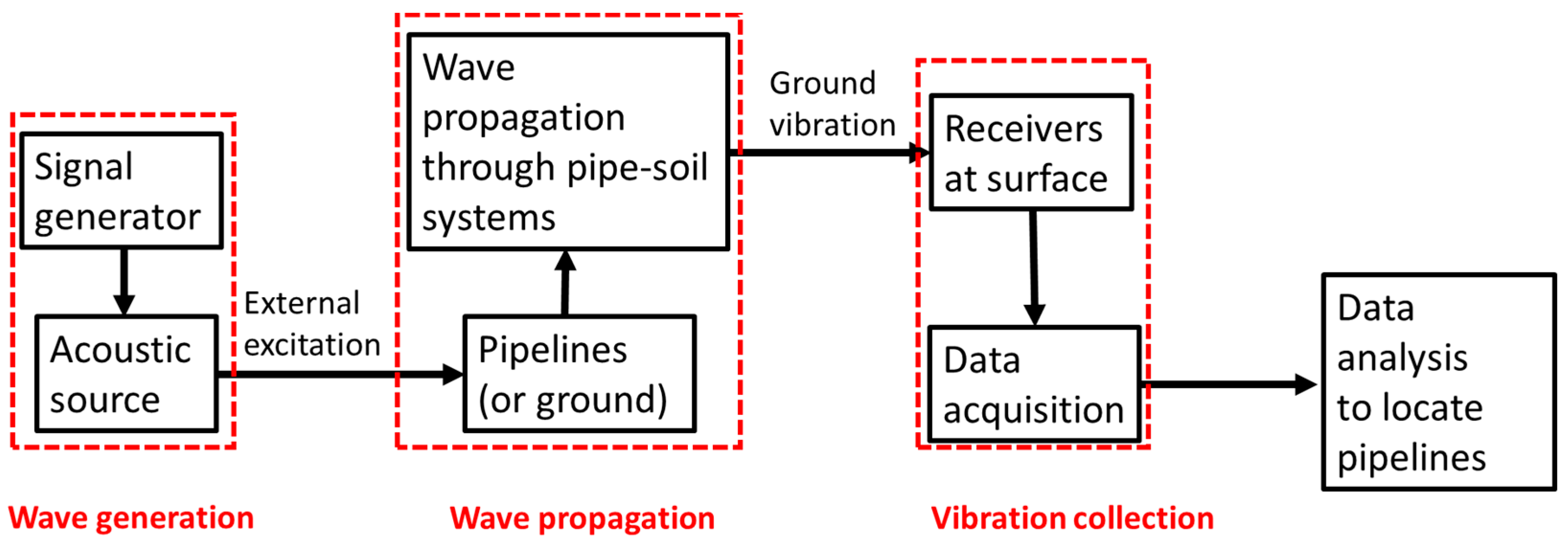

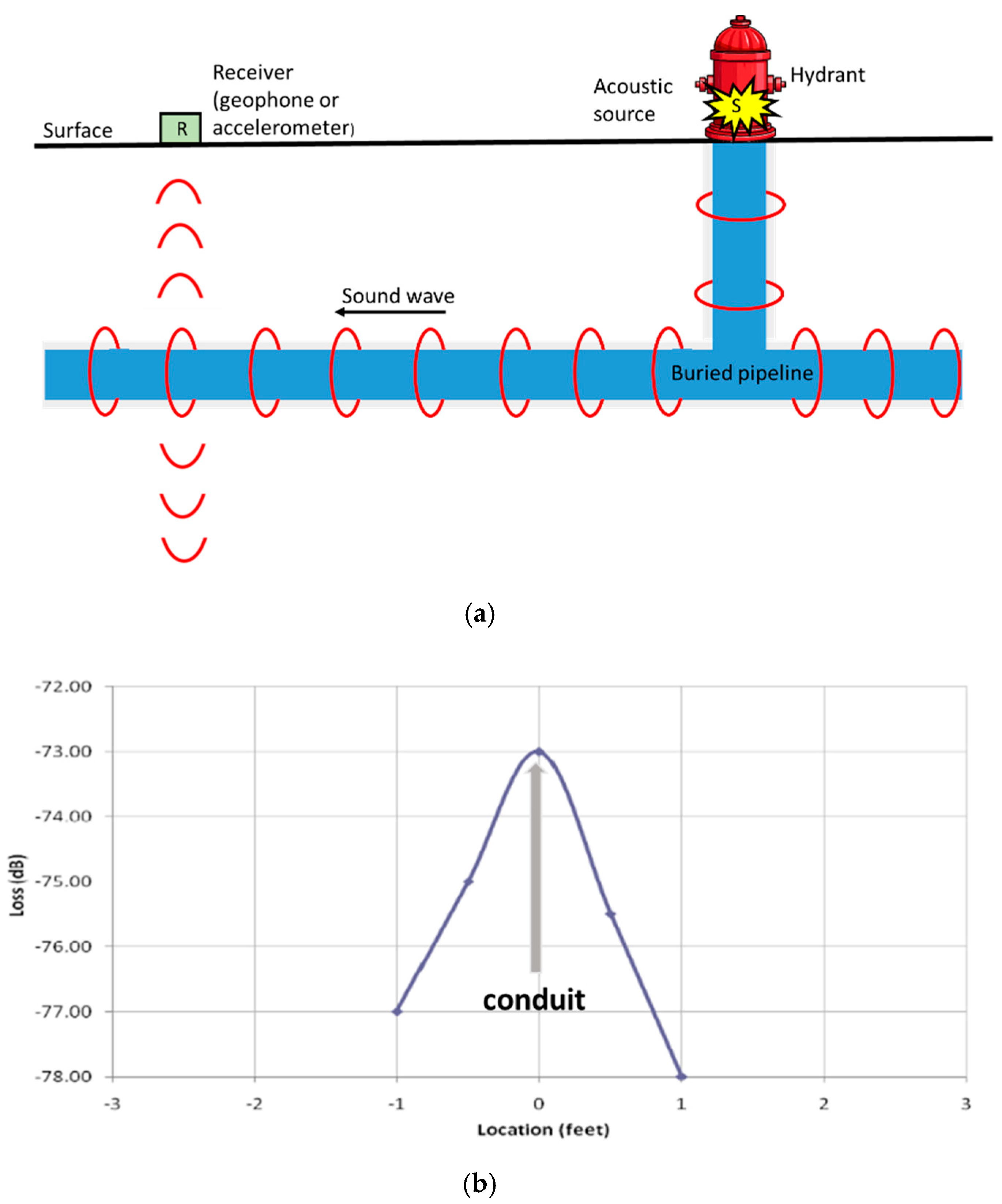


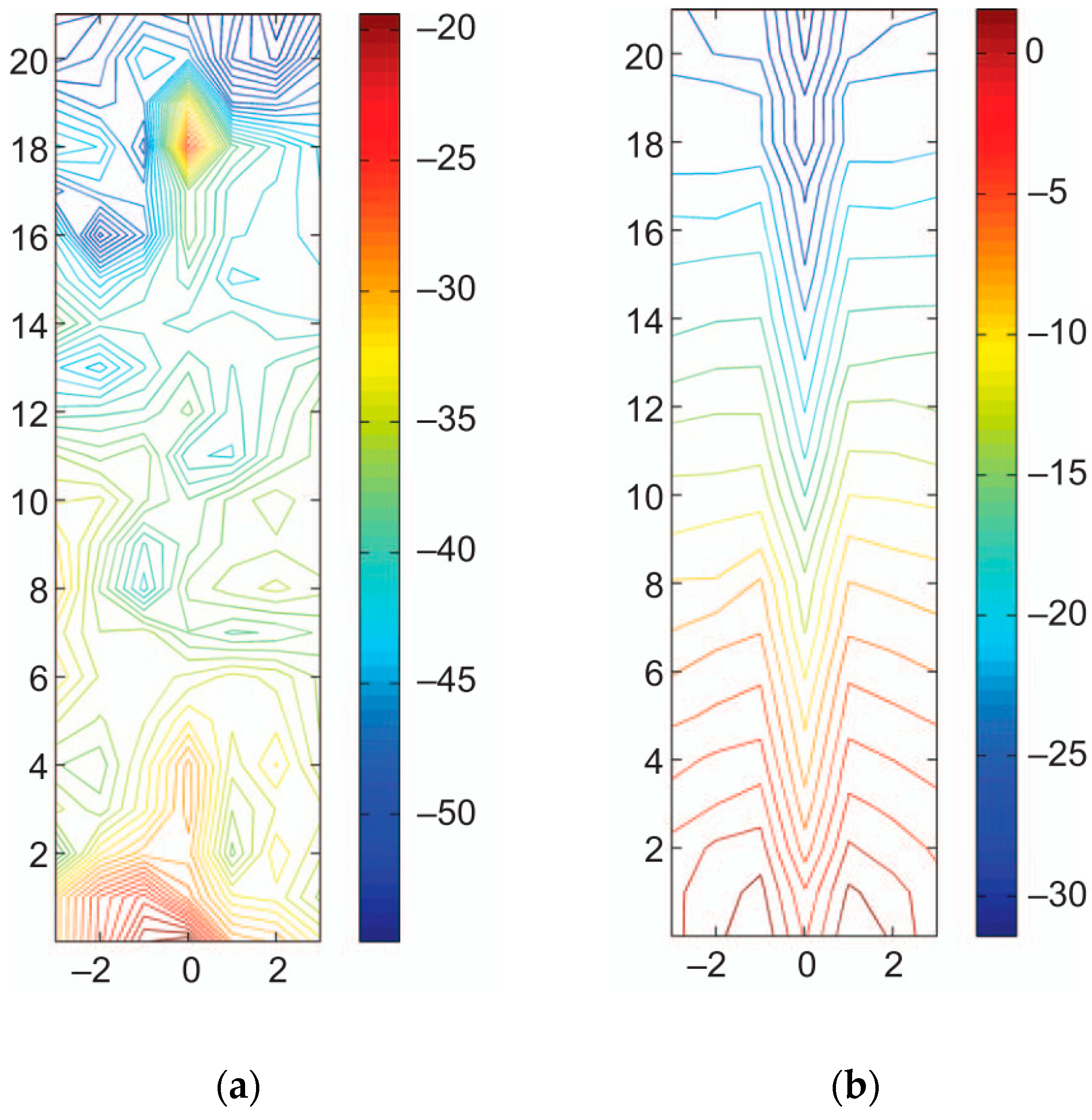

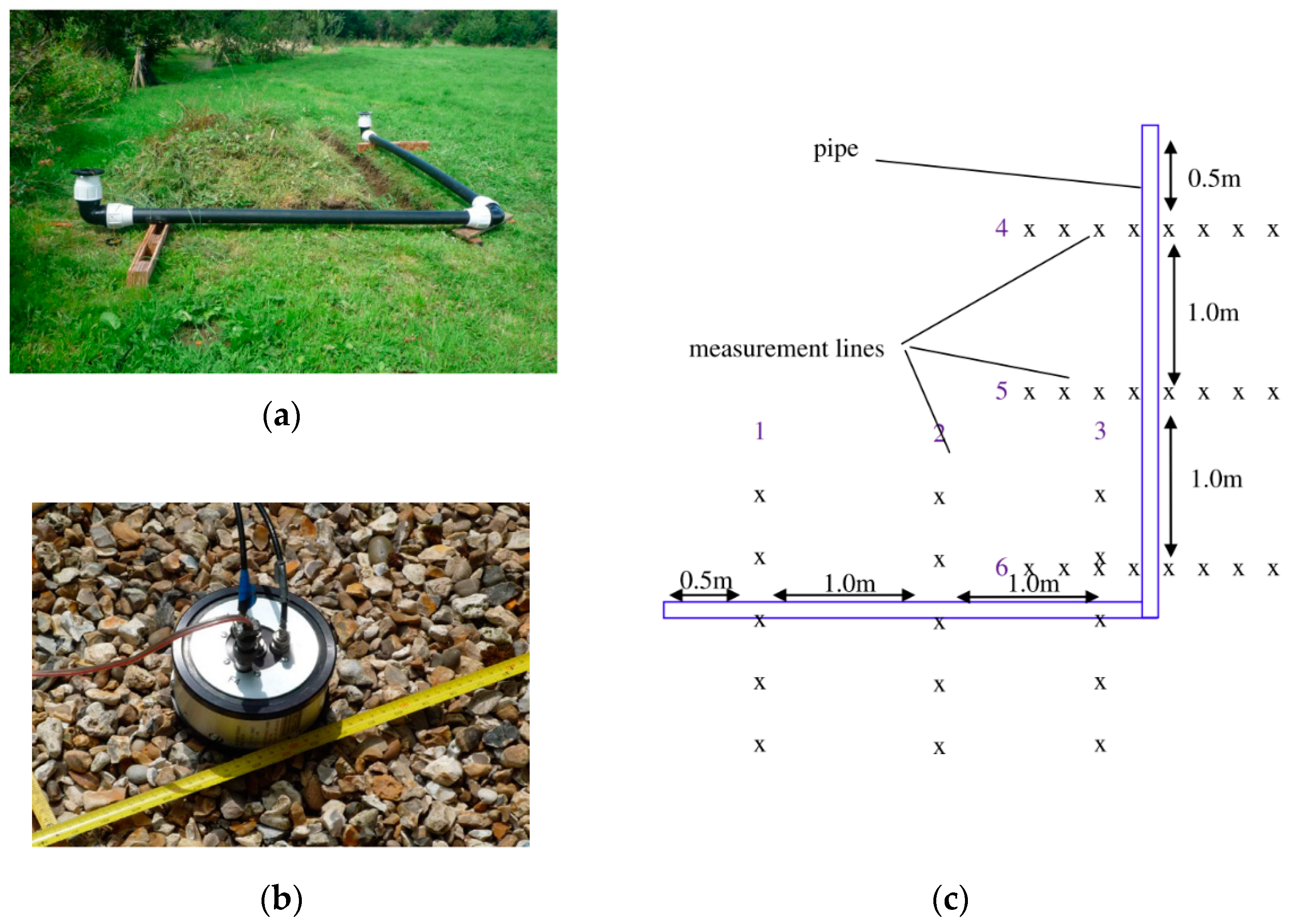
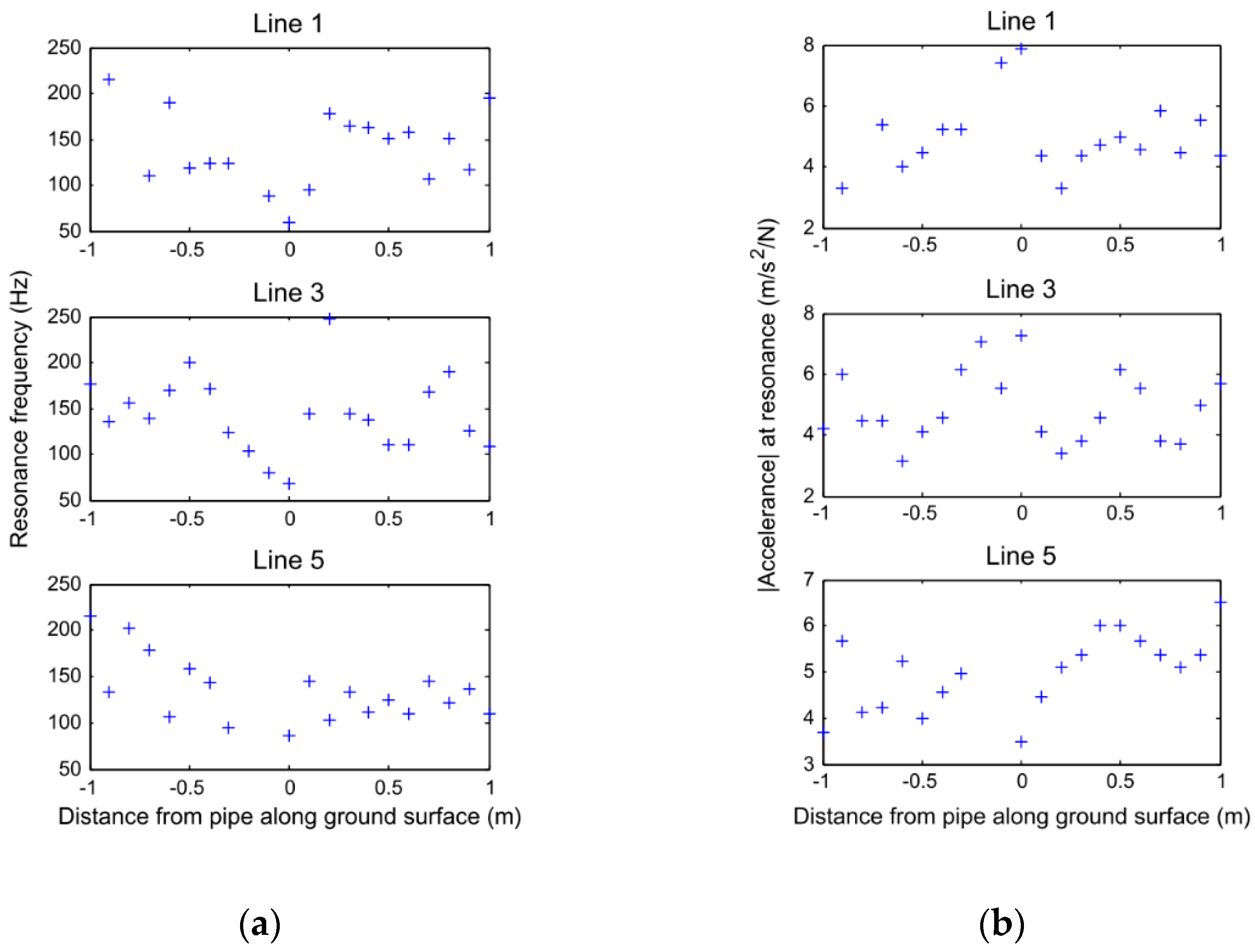



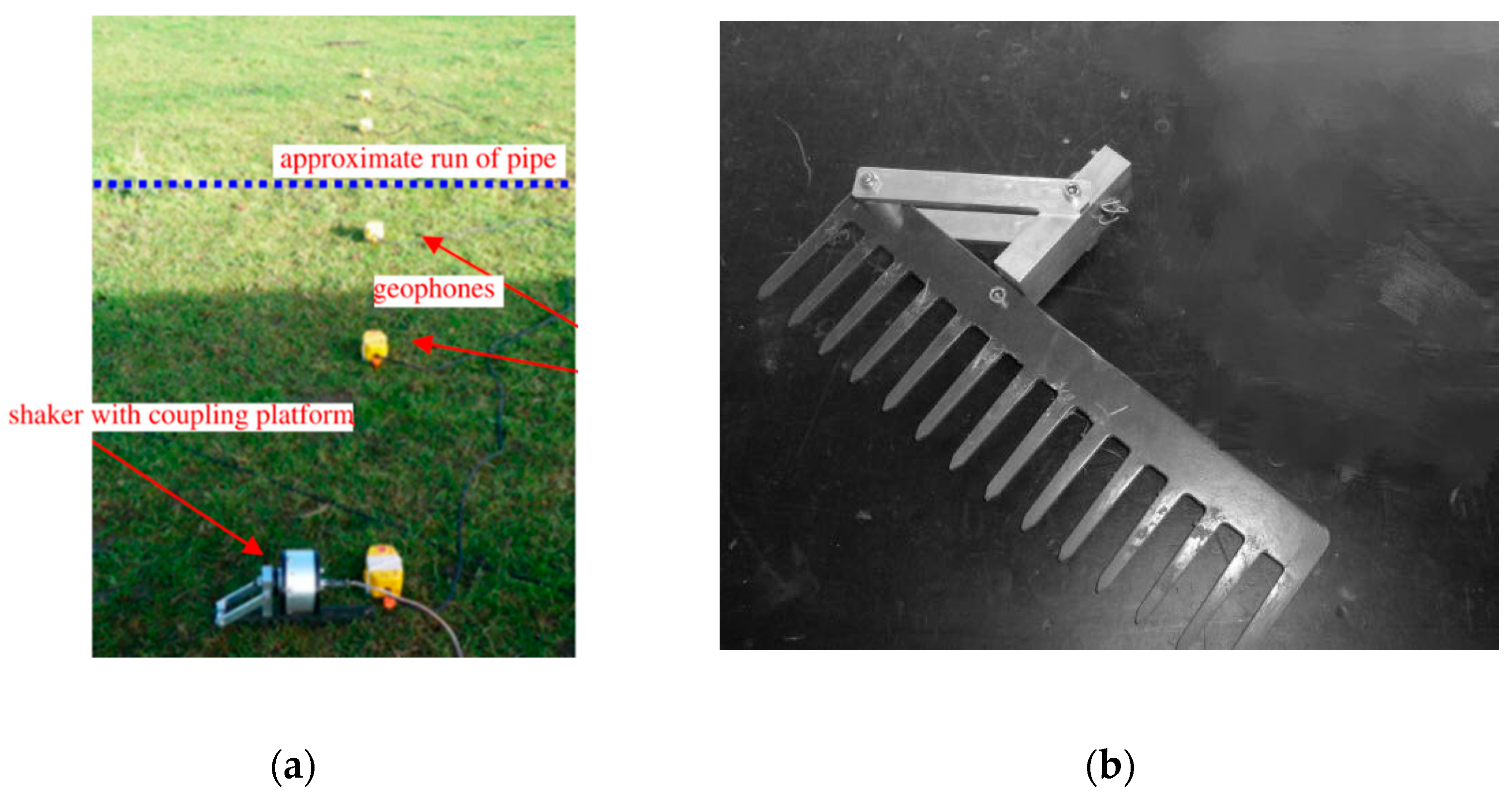

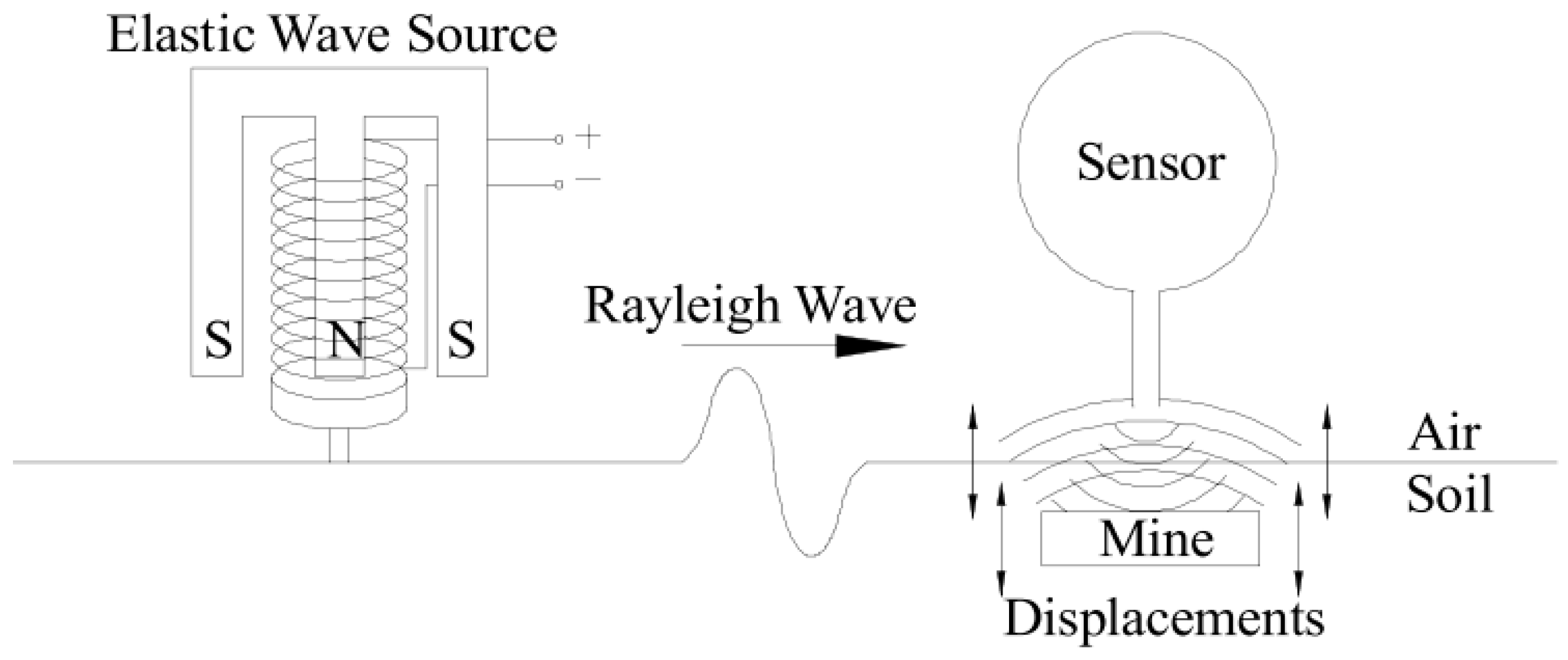

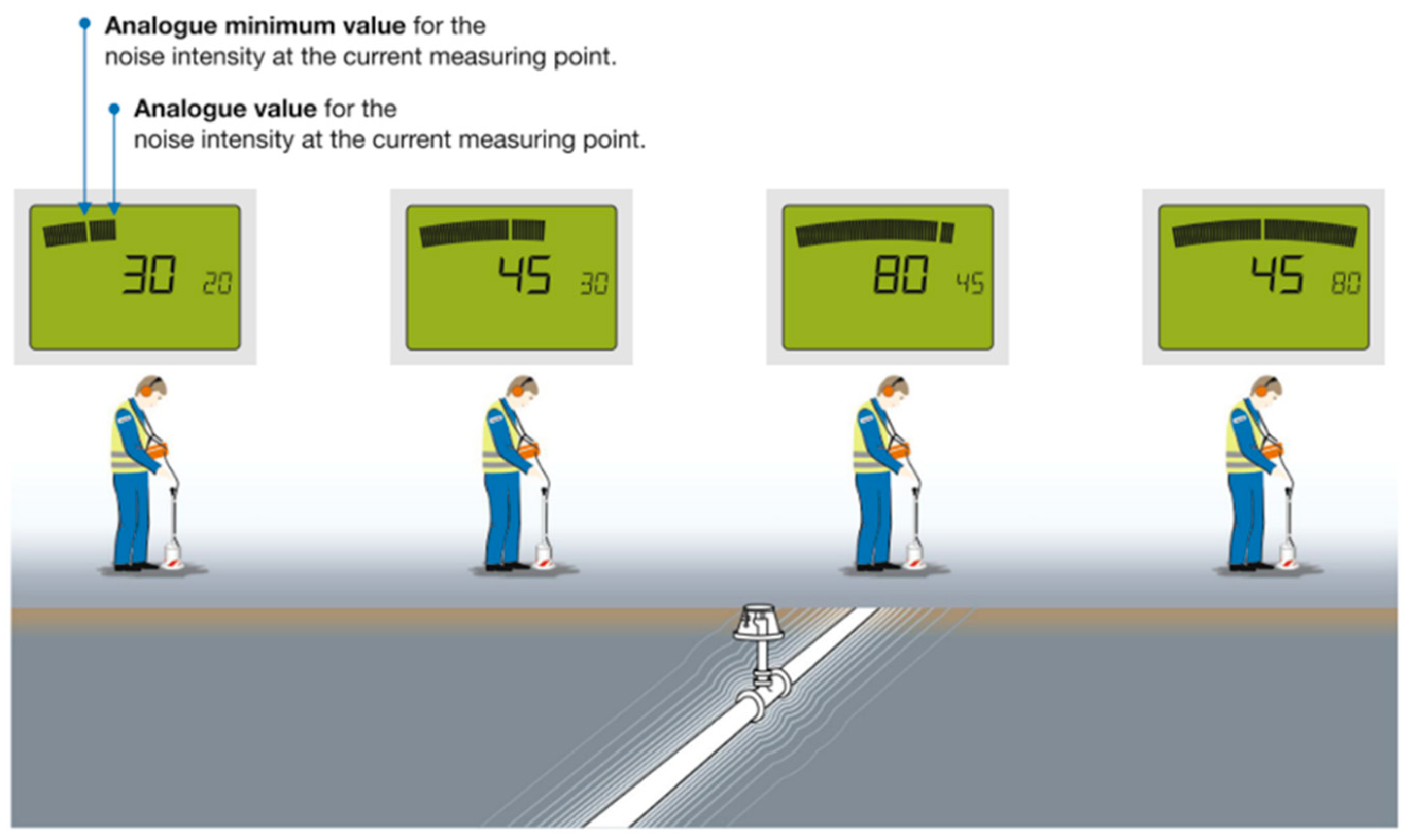
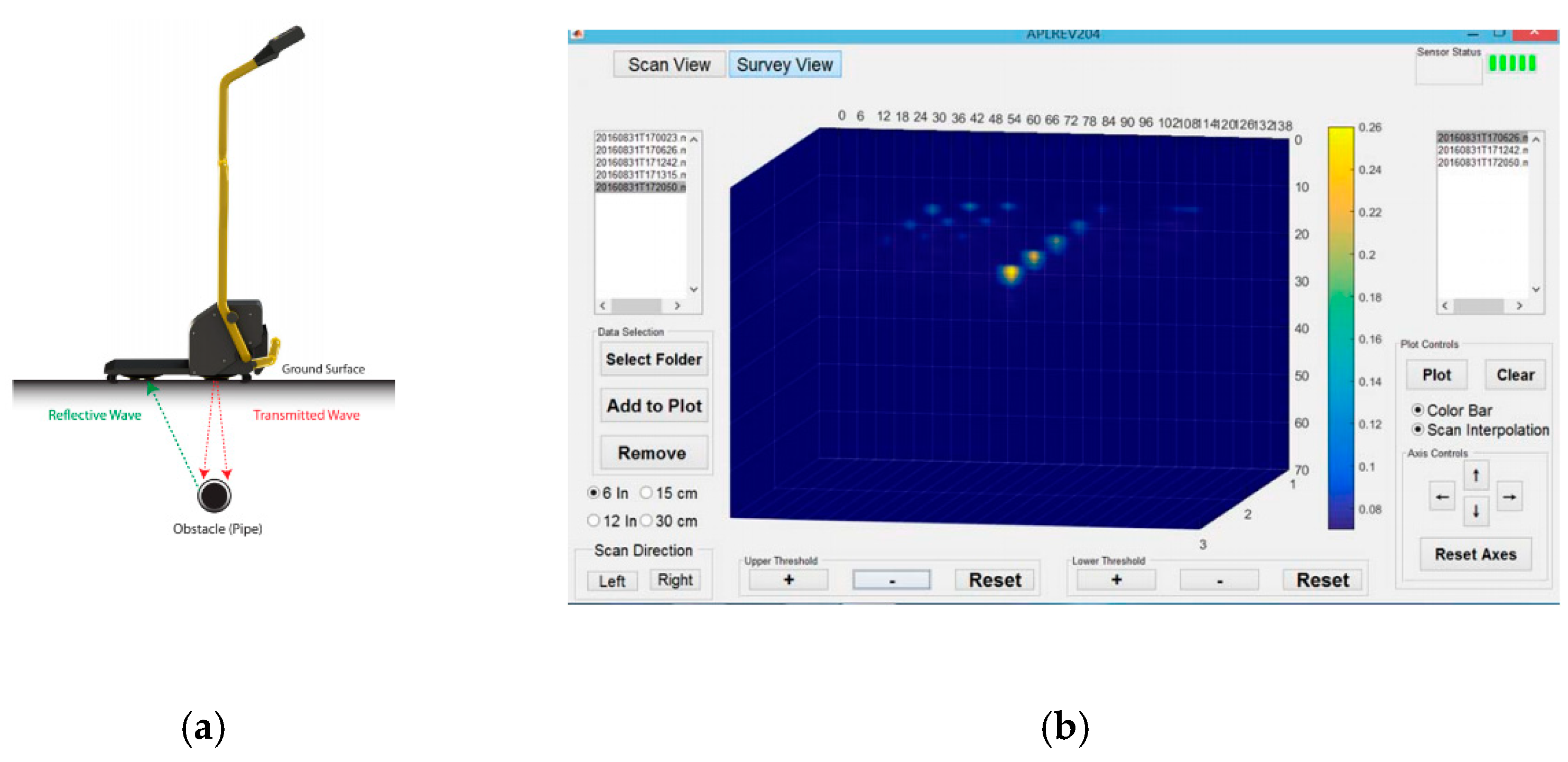
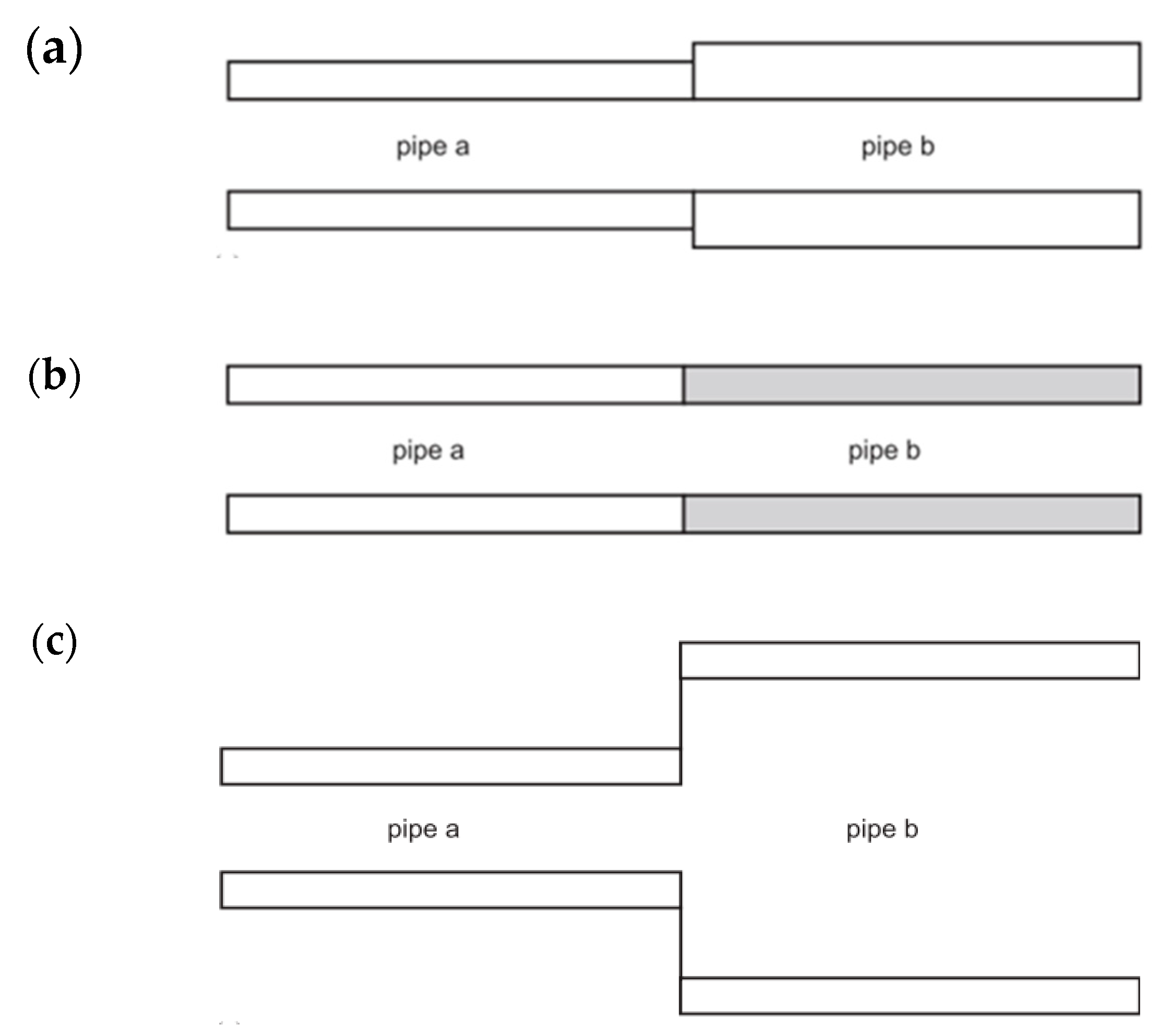
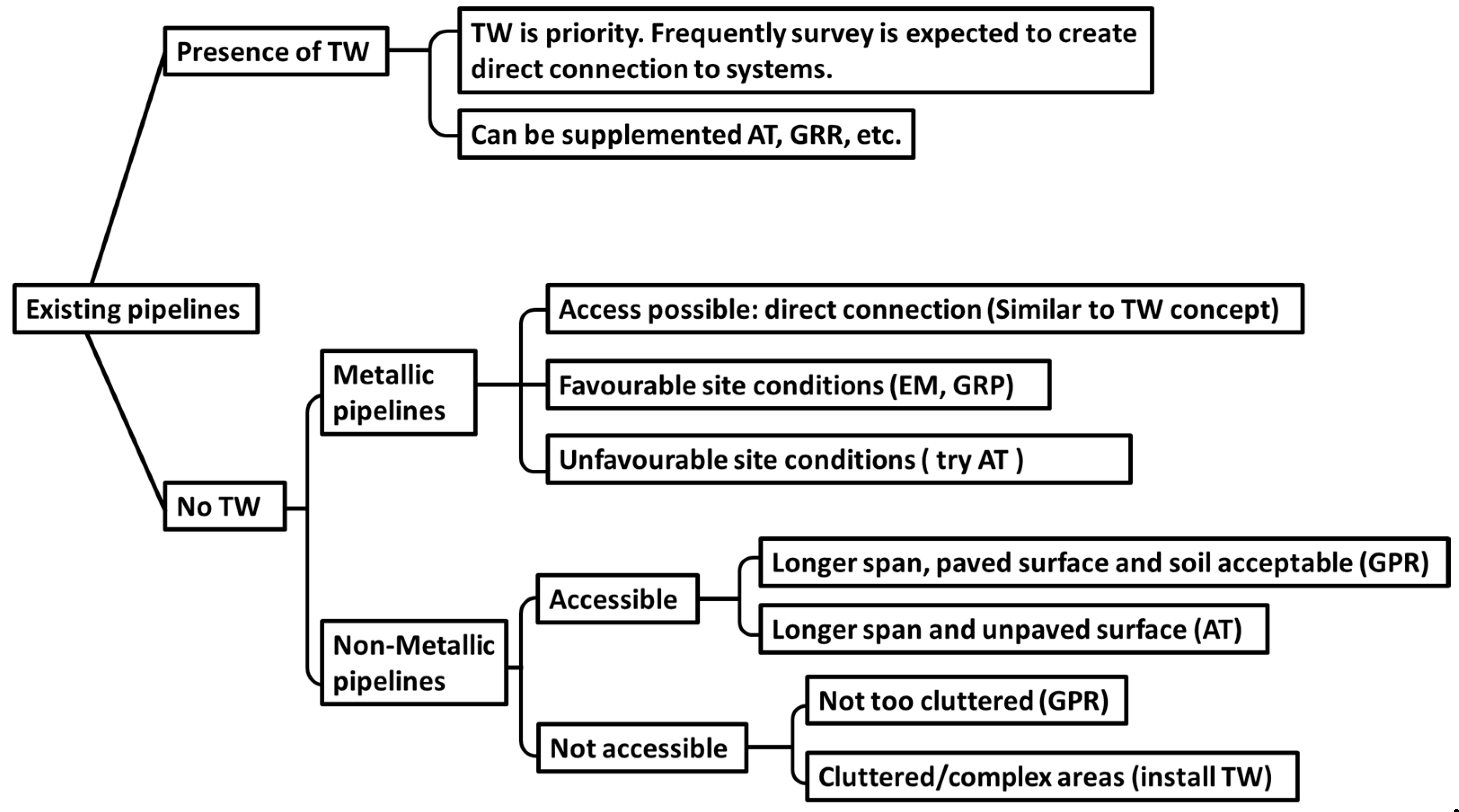
| Refs. | Model Description | Experimental Set-Up | Study Summary |
|---|---|---|---|
| [26] | Infinite hollow cylinders covering the transition from the case of a thin shell to the Pochhammer case of a solid cylinder | - | Plane-strain vibrations both axially symmetric and non-axially symmetric |
| [28,29] | A hollow circular cylinder of infinite extent | - | Three-dimensional investigation of the most general type of harmonic waves |
| [32] | Liquid-filled elastic tubes waveguides: PVC (Polyvinyl chloride) and aluminum | A thick-walled aluminum tube containing water with its lower end closed by a Lucite plate; A PVC water pipe dosed by a thin plastic insert at its bottom | Low-frequency propagation modes ET0 and ET1, dispersion behaviours and particle displacement profiles |
| [33,34] | Five cases including a cylindrical shell in vacuum (V/S/V), a cylindrical shell surrounded by a liquid (V/S/L), a hypothetical liquid column(L/V), a cylindrical shell filled with liquid (L/S/V), and a cylindrical shell immersed in an infinite liquid (L/S/L) | Steel cylindrical shells of 1 m suspended in either a water tank for the (L/S/L) measurements or in air for the (V/S/V) measurements; The shells filled with air or water and suspended in water or air for the cases (V/S/L) and (L/S/V). Water is the liquid and air is the equivalent of the vacuum | Dispersion curves, attenuation due to radiation, displacement distribution and stress distribution |
| [46,47,48,49] | Cylindrical elastic shells (steel, hard rubber[46]) filled with fluid; an infinite cylindrical elastic shell (steel) [49] | - | Wave propagation behaviours, energy distribution, vibration and radiation from monopole excitation |
| [63,64] | Fluid-filled pipes surrounded by an infinite elastic medium which can support both longitudinal and shear waves | A water-filled MDPE (Medium-density polyethylene) pipe of 2 m in air, secured vertically, with the lower end sealed; The MDPE pipe is terminated at each end in a large tank, being laid in the standard manner in a mostly sand backfill | Two axisymmetric wave types: fluid dominated wave and an axial shell wave |
| [65] | A submerged plastic water pipe | A water-filled MDPE pipe of 2 m, secured vertically, with the lower end sealed and suspended in water tank | The low-frequency acoustic propagation and attenuation characteristics |
| [66] | Buried fluid-filled pipes: inclusion of shear coupling at a lubricated pipe/soil interface | Same as [63,64] | The effects of shear coupling in lubricated contact condition |
| [58,68,70] | Fluid-filled pipes (PVC and cast iron) buried in sandy soil and clay soil, with no slippage between the soil and the pipe wall | Same as [63,64]; A 150 mm diameter PVC pipe of 200 m, buried in soft clay soil at a depth of 2.4 m [80] | Fluid-dominated wave; shell-dominated wave, structure and fluid motions; ground displacements due to fluid-dominated wave |
| [71] | A buried gas-filled steel pipe | The steel pipe with diameter of 5.08 cm m and a wall thickness of 4.76 mm, buried 0.762 m beneath the surface | Surface displacements due to gas-dominated wave |
| [75,76,77,78] | Buried iron water pipes | A 21.8 m long section of 4-inch bore pipe; A 19.8 m long section of 6 inch bore pipe; A 18.8 m long section of 10 inch bore buried street mains; A longer 49.1 m section of 6 inch bore pipe [75]; Buried 6 inch bore ductile iron water mains [76,77,78]. | The dispersion behaviour, displacement contribution, the effects of soil properties and attenuation characteristics |
| Representative Locators | Source and Receiver | Limitations | Optimal Detection Range | Advantages |
|---|---|---|---|---|
| FUJI NPL-100 [122] | Piezoelectric acceleration sensor; vibrator oscillator |
| ||
| RADIO DETECTION RD500 [123,124] | 3 transmitters to suit different application points; 2 devices for probing the soft and hard surface, respectively | Locating reduced for the pipe under pavement or concrete; Locate range reduced at the point where the pipe goes into a tee or joins a larger pipe |
|
|
| SEWERI System Combiphon [116,125] | Generator G5 central control unit and various impulse generators; 2 oscillators (Knocker, Stopper) |
| ||
| Ultra-Trac® APL [118,126] | Cannot detect objects less than 12” deep |
|
|
| Acoustic Methods | Access to Pipe | Data Collection | Imaging Type | Information of Pipe Location | Strengths | Limitations | |
|---|---|---|---|---|---|---|---|
| Traditional acoustic transmission method | Required | Single-sensor | Cross-sectional image | Run of the pipe |
|
| |
| Pipe excitation method | Required | Multi-sensors | Top view | Run of the pipe |
|
| |
| Point vibration measurements | Not required | Single-sensor | Cross-sectional image | Run of the pipe |
|
| |
| Seismic wave methods | Compressional wave method | Not required | Multi-sensors | Cross-sectional image | Lateral location and burial depth |
|
|
| Shear wave method | |||||||
| Surface wave method | |||||||
| Methods | Applications and Limitations |
|---|---|
| Trace wires (TW) [150] |
|
| Groun penetrating radar (GPR) [5] |
|
| Electromagnetic methods (EM) [9] |
|
| Magnetic mehtods (MM) [151] |
|
| Infrared thermography (IF) [18] |
|
© 2020 by the authors. Licensee MDPI, Basel, Switzerland. This article is an open access article distributed under the terms and conditions of the Creative Commons Attribution (CC BY) license (http://creativecommons.org/licenses/by/4.0/).
Share and Cite
Liu, Y.; Habibi, D.; Chai, D.; Wang, X.; Chen, H.; Gao, Y.; Li, S. A Comprehensive Review of Acoustic Methods for Locating Underground Pipelines. Appl. Sci. 2020, 10, 1031. https://doi.org/10.3390/app10031031
Liu Y, Habibi D, Chai D, Wang X, Chen H, Gao Y, Li S. A Comprehensive Review of Acoustic Methods for Locating Underground Pipelines. Applied Sciences. 2020; 10(3):1031. https://doi.org/10.3390/app10031031
Chicago/Turabian StyleLiu, Ying, Daryoush Habibi, Douglas Chai, Xiuming Wang, Hao Chen, Yan Gao, and Shuaiyong Li. 2020. "A Comprehensive Review of Acoustic Methods for Locating Underground Pipelines" Applied Sciences 10, no. 3: 1031. https://doi.org/10.3390/app10031031





